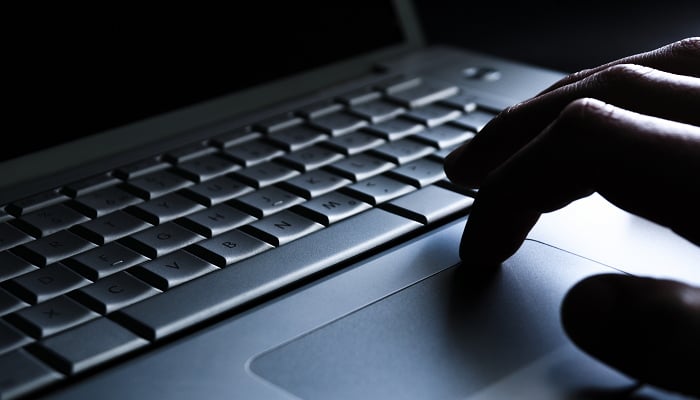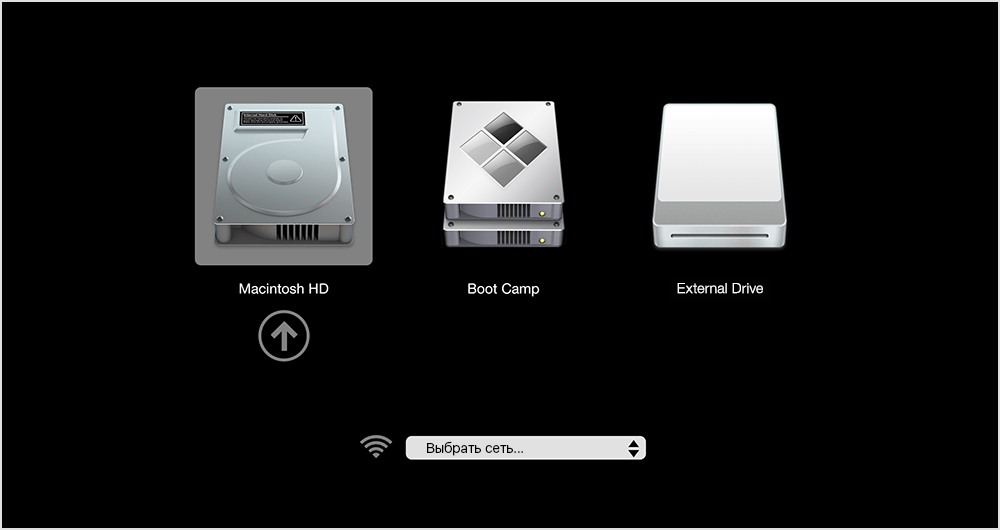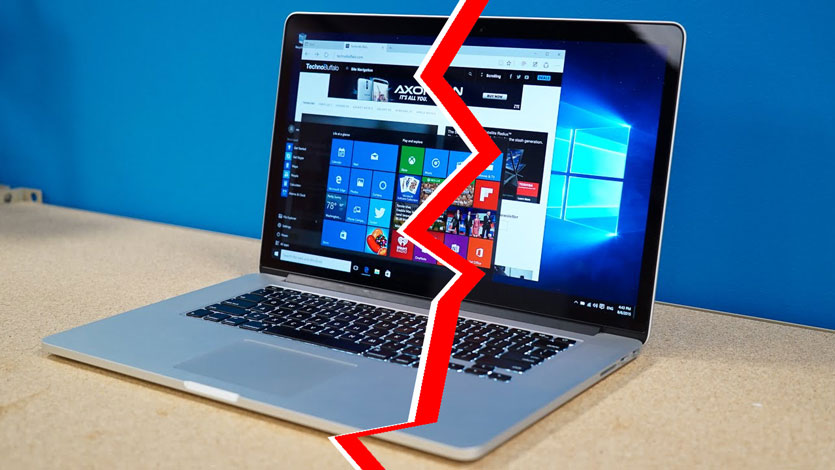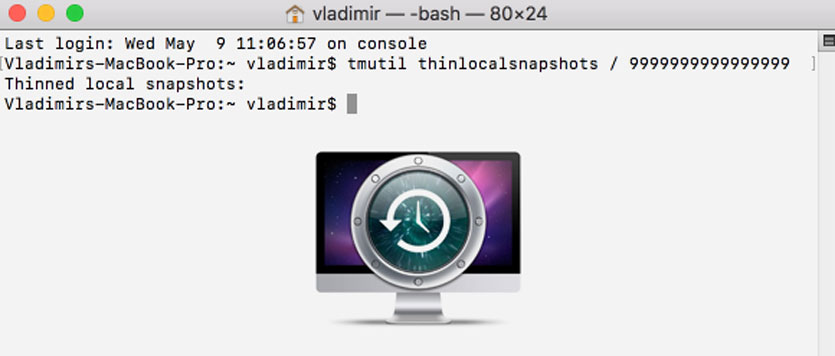Looks like no one’s replied in a while. To start the conversation again, simply
ask a new question.
Installed Windows 10 via bootcamp this morning on my early 2013 15″ rmbp. Followed an instructional video on YouTube step-by-step and everything went fine until Windows itself started up. Brought me to the W10 homepage but unlike on the video I was watching, a pop up prompt from Bootcamp never appeared. I am now stuck in Windows 10 and cannot locate a Bootcamp icon anywhere and there is no option to turn on wifi in Windows 10 so I am also stuck without an Internet connection either seeing as I have no Ethernet port on my MacBook. Any help is greatly appreciated.
MacBook Pro with Retina display
Posted on Sep 5, 2015 10:45 AM
Can’t find bootcamp icon in windows 10
Содержание
- bootcamp пропала mac os
- Процедура переключения между Windows и macOS
- Дополнительная информация
- Как заставить Bootcamp работать
- Fix: Boot Camp Icon Is Missing From Taskbar System Tray
- Check if Boot Camp icon is hidden
- Make sure that Boot Camp Manager is starting with Windows
- Add Boot Camp icon to taskbar system tray
- Related Articles
- Comments
bootcamp пропала mac os
Вам может потребоваться обновление macOS или более поздний выпуск Windows 10.
При определенных обстоятельствах во время копирования установочных файлов Windows программа «Ассистент Boot Camp» может перестать отвечать или в ней может появиться сообщение «Установка Boot Camp не удалась». Попробуйте решить проблему следующим образом:
Если в программе «Ассистент Boot Camp» появится сообщение, что не удается разбить загрузочный диск на разделы или восстановить единый раздел, выполните следующие дополнительные действия:
- Откройте программу «Дисковая утилита» в подпапке «Утилиты» папки «Программы».
- Выберите на боковой панели загрузочный диск компьютера Mac (Macintosh HD).
- На панели инструментов программы «Дисковая утилита» нажмите кнопку «Разбить на разделы».
- Если программа «Дисковая утилита» предложит выбор, добавить том в контейнер или разбить устройство на разделы, выберите «Разбить на разделы».
- Нажмите OSXRESERVED на открывшемся графике, затем нажмите кнопку удаления (–) под графиком.
- Нажмите BOOTCAMP на графике, затем нажмите кнопку удаления (–).
OSXRESERVED и BOOTCAMP — это пустые разделы, созданные программой «Ассистент Boot Camp» при неудавшейся установке. - Нажмите «Применить» и подтвердите это действие нажатием кнопки «Разбить на разделы».
- Откройте программу «Ассистент Boot Camp» и повторите попытку установки Windows.
Информация о продуктах, произведенных не компанией Apple, или о независимых веб-сайтах, неподконтрольных и не тестируемых компанией Apple, не носит рекомендательного характера и не рекламируются компанией. Компания Apple не несет никакой ответственности за выбор, функциональность и использование веб-сайтов или продукции сторонних производителей. Компания Apple также не несет ответственности за точность или достоверность данных, размещенных на веб-сайтах сторонних производителей. Помните, что использование любых сведений или продуктов, размещенных в Интернете, сопровождается риском. За дополнительной информацией обращайтесь к поставщику. Другие названия компаний или продуктов могут быть товарными знаками соответствующих владельцев.
Нажмите и удерживайте клавишу Option во время запуска, затем выберите загрузочный диск Windows или macOS.
После установки Microsoft Windows на компьютере Mac с помощью программы Boot Camp используйте для переключения между Windows и macOS программу «Менеджер загрузки».
Процедура переключения между Windows и macOS
- Перезапустите компьютер Mac, затем сразу нажмите и удерживайте клавишу Option или Alt (⌥).
Для перезапуска из macOS выберите меню Apple () > «Перезагрузить». Чтобы выполнить перезапуск из Windows, нажмите кнопку «Пуск», затем щелкните значок питания и выберите «Перезагрузка». - Отпустите клавишу Option, когда появится окно менеджера загрузки:
- Выберите загрузочный диск macOS или Windows (Boot Camp), затем щелкните стрелку под его значком или нажмите клавишу «Ввод».
Повторяйте эти действия каждый раз при необходимости переключиться между операционными системами.
Дополнительная информация
- Если вы используете функцию VoiceOver или другую программу голосового сопровождения интерфейса и вам нужна помощь с переключением между Windows и macOS, обратитесь в службу поддержки Apple.
- При выборе пункта Restart in OS X (Перезапуск в OS X) в меню Boot Camp в Windows возможен вывод сообщения Could not locate the OS X boot volume (Не удалось найти загрузочный том OS X). Воспользуйтесь приведенной выше процедурой, чтобы переключиться в операционную систему Mac.
Информация о продуктах, произведенных не компанией Apple, или о независимых веб-сайтах, неподконтрольных и не тестируемых компанией Apple, не носит рекомендательного характера и не рекламируются компанией. Компания Apple не несет никакой ответственности за выбор, функциональность и использование веб-сайтов или продукции сторонних производителей. Компания Apple также не несет ответственности за точность или достоверность данных, размещенных на веб-сайтах сторонних производителей. Помните, что использование любых сведений или продуктов, размещенных в Интернете, сопровождается риском. За дополнительной информацией обращайтесь к поставщику. Другие названия компаний или продуктов могут быть товарными знаками соответствующих владельцев.
Как бы Apple не гордилась своей новой файловой системой APFS, разработчики незаметно подложили свинью пользователям, которые привыкли пользоваться несколькими ОС. В частности, речь идет об установке Windows посредством штатной утилиты Bootcamp.
А все проблема в том, что после перехода на файловую систему APFS, вы столкнетесь с трудностями еще на стадии форматирования раздела.
Вначале все идет нормально, но приблизительно на прогрессе в 15% высвечивается ошибка «Вас диск не может быть разделен».
Попытки запуска Дисковой утилиты и «лечение» разделов не помогают. Как выяснилось, проблема действительно в файловой системе APFS и резервных копиях Time Machine. В резервных копиях Time Machine с HPFS Bootcamp работает без проблем.
Как заставить Bootcamp работать
Есть вариант решения проблемы, который подойдет в том случае, если системе не хватает места для операции форматирования.
Шаг 1. Отключите диск, на который ведется запись резервных копий Time Machine. Если не пользуетесь резервными копиями, просто пропустите этот шаг.
Шаг 2. Откройте Терминал (из раздела Утилиты) и введите следующую команду:
tmutil thinlocalsnapshots / 9999999999999999
Через несколько секунд (иногда минут — зависит от производительности вашего Mac) вы увидите статус выполнения команды “Thinned local snapshots”.
Шаг 3. Запустите Дисковую утилиту, выберите раздел, на котором установлена macOS High Sierra и выберите пункт Первая помощь —> Запустить.
После выполнения этих шагов можете приступать к созданию раздела под Bootcamp. Никаких ошибок больше не будет. Если же данный вариант не помогает, приготовьтесь к полному форматированию системы в HFS+ и накатку macOS High Sierra с нуля. [Volvitam]
На всякий случай, наш классный Telegram канал. Заходи!


Fix: Boot Camp Icon Is Missing From Taskbar System Tray
Last Updated on January 16, 2018 by admin 11 Comments
Installing Windows on a Mac using the official Boot Camp Assistant software is certainly the easiest and best way of installing Windows on a Mac computer. In addition to the fact that it’s extremely easy to use and setup, when you install Windows using Boot Camp, Windows and apps will have full access to the hardware unlike virtual machines.
After installing Windows on Mac using Boot Camp, you need to install the Boot Camp drivers in order to get trackpad and other features working.
With default settings, Boot Camp sits in the system tray area of taskbar and lets you quickly access Boot Camp Control Panel which in turn allows you change default start up disk and a couple of keyboard and trackpad settings. The other advantage of having Boot Camp icon in the system tray is that you can quickly reboot into Mac OS X by right-clicking on the Boot Camp icon and then clicking Restart in OS X option.
But if for some reason, the Boot Camp icon is missing from the system tray area and it used to appear when you had installed Boot Camp for the first time, you can follow the given below instructions to add the same to system tray in Windows.
Method 1:
For Windows 10
(Scroll down for previous Windows versions)
Step 1: Open the Settings app. Navigate to Personalization > Taskbar.
Step 2: In the Notification area section, click Select which icons appear on taskbar link.
Step 3: In the resulting page, turn on Boot Camp Manager entry.
For Windows 8/8.1
Step 1: Click on the small up arrow icon in the system tray (see picture ) to see hidden icons and then click Customize option.
Step 2: Scroll down the list to see if Boot Camp Manager entry is present. If Boot Camp Manager is exist, set its behaviour to Show icon and notifications by selecting the same from the drop down menu. And if Boot Camp icon doesn’t exist there, follow the instructions mentioned in Method 2.
Method 2:
Make sure that Boot Camp Manager is starting with Windows
If you are on Windows 10/8.1:
Step 1: Open Task Manger by right-clicking on the empty space of the taskbar and then clicking Task Manager option.
Step 2: Switch to the Startup tab and make sure that Boot Camp isn’t disabled here. If it’s disabled, select Boot Camp entry and then click Enable. That’s it!
If you’re on Windows 7:
Step 1: Open System Configuration utility. To do that, open Run dialog with the help of Command + R hotkey, type Msconfig in the box and the press enter key.
Step 2: Switch to the Startup tab and then make sure that Boot Camp Manager is starting with Windows.
Method 3
Add Boot Camp icon to taskbar system tray
NOTE: This method works on Windows 10/8/7.
Step 1: Open Control Panel. To do this, open Run dialog box by simultaneously pressing Windows logo and R keys. In the resulting box, type Control.exe, and then press Enter key.
Step 2: Change the Control Panel view to Small icons. You should now see Boot Camp applet in the Control Panel.
Step 3: Right-click on the Boot Camp applet and then click Create shortcut to create a shortcut of Boot Camp on the desktop.
Step 4: Next, you need to put this shortcut in the Startup folder. To do so, open Run dialog box again with the help of Windows + R hotkey.
Step 5: In the Run box, type shell:startup and then press enter key to open Startup folder.
Step 6: Now, copy or move the shortcut that you have just created on the desktop to the Startup folder. That’s it!
Step 7: Restart your PC to see the Boot Camp in the system tray. From here onwards, Boot Camp icon will automatically start with Windows and will be available to access from system tray.
Filed Under: Windows 10 Tagged: Mac
Related Articles
I tried all article’s methods multiple times, did not work, Boot Camp icon does not appear in the systray at all. Also, Boot Camp forgets settings very often, at least on every sleep/resume. And shows incorrect options selected, i.e. Boot Camp Control Panel settings do not correspond the actual active settings. And the F-keys settings (“Use all F1…”) on the touchbar randomly revert spontaneously. It’s all extremely buggy. Not to mention zero support from Apple, almost zero support on display drivers (huge incompatibilities), extremely bad drivers for WiFi and Bluetooth…. The list is endless. Basically Apple does not support Windows at all, Boot Camp is just a dying legacy relic. Well, the new M1 processor apparently won’t support Windows anyway, so that’s it, then.
Anyway, if somebody knows new methods to get the Boot Camp systray icon visible, please tell.
I accidentally deleted Boot Camp from startup. I use the startup Manager. There used to be an entry for Boot Camp. Now it’s gone, and I don’t remember what it looked like. I ask the Boot Camp user to view the boot Camp startup path for me. Do this please, look in some startup Manager please!
I have a MacBookPro Model 11.3 (15″ Retina) with BootCamp Windows 7 Ultimate SP1. I used to have the BootCamp icon in the System Tray. Recently, I notice the icon is no longer there (don’t know when did that happened).
I followed the instrustions of here how to fix the problem, but for my machine, it didn’t worked.
Ithen thought reinstalled (run setup.exe) of my BootCamp driver package (the same old one used for this machine) thinking that would solve the issue, time of that was the last night before. Then my nightmare started and lost hours of sleep.
I rebooted the machine after the reinstallion of the BootCamp package, and all I got was BOD; BLUE SCREEN OF DEATH in Windows; worst kind scenario of ALL.
THEN;
I did reboot from Last Know Good Restore Point, BOD;
I booted it in Safe Mode, yes it worked and start to unintall drivers;
one at a time and reboot once at a time -> BOD.
I did System Restore from recent restore point. –> BOD;
I did System Restore from an older restore point. –>BOD;
I did System Restore from an even older restore point. –>BOD;
I did System Restore from an even older, older restore point. –>BOD;
Frustrated;
I recalled by accident I backed up my System Retore Point recently with a 3rd party software named Advanced Uninstaller.
I booted the machine up with Safe Mode (still worked), ran the software and restored the restore point.
ShutDown the machine and reboot and kept my finger crossed.
It booted up with the Windows 7, icon locations scrambled, screen resolution screwed up, BootCamp ControlPanel icon still not found in System Tray but at least not BOD. All I needed to do is find out what is missing and reinstall.
Moral of the story is: Don’t mess with BootCamp. I went through 3 MacBookPro 15.4″ with BootCamp Windows 7, unbelievable amount of hours losted in keeping the machine running software-wise.
I don’t recommand novice Windows users using Apple Machines running BootCAMP. .
P.S. I also had a 21″ iMac running with BootCamp ( I bought the machine when it was on sales saving $400).
The machine BootCamp died and I still couldn’t get it worked again. The Mac portion is OK but I have things in the BootCamp section that I don’t want to rebuilt the BootCamp section and lose everything.
I have a similar problem with Windows 10 running via Bootcamp on a mid 2012 Macbook Air.
The output of my problem is, that specific functions doesn’t work, such as the right click (two finger click), scrolling with two fingers and the function keys behind the F1 till F12 keys.
Also the bootcamp icon isn’t there.
It seams like its a driver problem, even though I tried do manually download the drivers with the boocamp assistant on mac.
In your online manual you are saying that to disable the bootcamp icon I could just enable it with cmd+S/settings/taskbar/enabling it or task manager/startup/bootcamp or control panel/bootcamp.
My problem is that following all these solutions, I can’t find bootcamp anywhere.
It is like bootcamp just dosn’t exist here.
Do you have any idea about what could be wrong?
@ Person
Thanks for letting us know the that typo. We have corrected it.
Not seeing Boot Camp anywhere within Windows 10. I tried all control panel items and it is simply nowhere. I cannot get my keyboard to light up, scrolling doesn’t work, and the touchbar no longer comes on. I have gone into MacOS and when I try to open Boot Camp Assistant there is an error that says I have to reformat the drive to OSX Journaled. I do not believe this is true though because I am currently typing this from Windows 10 on my MBP. The Mac partition is APFS, and the Windows is just regular Windows NTFS.
This is the worst article ever. Bootcamp is for ppl with a Mac. If you have a Mac there is no windows key. Stop saying window + XYZ key. Worst
After all efforts if u do not find it in windows system,go in mac systems with action od simultaneously press power n optin key you will find both operating system start up icon select machentosh and open boot camp and action option then download bootcamp supporting files in a fat format usb drive then insatall in windows.after installation boot camp icon and its all supporting file will work.
My bootcamp icon is not showing anywhere. I have a MacBook Pro and I installed windows 7. I have followed all different instructions to find the bootcamp icon but it’s not anywhere. The bootcamp icon is not showing in “All Control Panel Items”
FWIW, if none of the above steps worked, I am guessing you may have had the same issue I did: installing Windows from DVD. When I installed Windows from USB, then the Boot Camp applet for the Control Panel showed up as were all the drivers properly installed.
You are here:
Home » Windows 10 » Fix: Boot Camp Icon Is Missing From Taskbar System Tray
Installing Windows on a Mac using the official Boot Camp Assistant software is certainly the easiest and best way of installing Windows on a Mac computer. In addition to the fact that it’s extremely easy to use and setup, when you install Windows using Boot Camp, Windows and apps will have full access to the hardware unlike virtual machines.
After installing Windows on Mac using Boot Camp, you need to install the Boot Camp drivers in order to get trackpad and other features working.
With default settings, Boot Camp sits in the system tray area of taskbar and lets you quickly access Boot Camp Control Panel which in turn allows you change default start up disk and a couple of keyboard and trackpad settings. The other advantage of having Boot Camp icon in the system tray is that you can quickly reboot into Mac OS X by right-clicking on the Boot Camp icon and then clicking Restart in OS X option.
But if for some reason, the Boot Camp icon is missing from the system tray area and it used to appear when you had installed Boot Camp for the first time, you can follow the given below instructions to add the same to system tray in Windows.
Method 1:
Check if Boot Camp icon is hidden
For Windows 10
(Scroll down for previous Windows versions)
Step 1: Open the Settings app. Navigate to Personalization > Taskbar.
Step 2: In the Notification area section, click Select which icons appear on taskbar link.
Step 3: In the resulting page, turn on Boot Camp Manager entry.
For Windows 8/8.1
Step 1: Click on the small up arrow icon in the system tray (see picture ) to see hidden icons and then click Customize option.
Step 2: Scroll down the list to see if Boot Camp Manager entry is present. If Boot Camp Manager is exist, set its behaviour to Show icon and notifications by selecting the same from the drop down menu. And if Boot Camp icon doesn’t exist there, follow the instructions mentioned in Method 2.
Method 2:
Make sure that Boot Camp Manager is starting with Windows
If you are on Windows 10/8.1:
Step 1: Open Task Manger by right-clicking on the empty space of the taskbar and then clicking Task Manager option.
Step 2: Switch to the Startup tab and make sure that Boot Camp isn’t disabled here. If it’s disabled, select Boot Camp entry and then click Enable. That’s it!
If you’re on Windows 7:
Step 1: Open System Configuration utility. To do that, open Run dialog with the help of Command + R hotkey, type Msconfig in the box and the press enter key.
Step 2: Switch to the Startup tab and then make sure that Boot Camp Manager is starting with Windows.
Method 3
NOTE: This method works on Windows 10/8/7.
Step 1: Open Control Panel. To do this, open Run dialog box by simultaneously pressing Windows logo and R keys. In the resulting box, type Control.exe, and then press Enter key.
Step 2: Change the Control Panel view to Small icons. You should now see Boot Camp applet in the Control Panel.
Step 3: Right-click on the Boot Camp applet and then click Create shortcut to create a shortcut of Boot Camp on the desktop.
Step 4: Next, you need to put this shortcut in the Startup folder. To do so, open Run dialog box again with the help of Windows + R hotkey.
Step 5: In the Run box, type shell:startup and then press enter key to open Startup folder.
Step 6: Now, copy or move the shortcut that you have just created on the desktop to the Startup folder. That’s it!
Step 7: Restart your PC to see the Boot Camp in the system tray. From here onwards, Boot Camp icon will automatically start with Windows and will be available to access from system tray.
-
#1
Mac Pro 5,1 2010.
Installed Sierra.
Installed Windows 10.
Everything is fine, but Boot Camp Manager is not appearing. I ran the program multiple times but not working. The version of Boot Camp is 5.0.3.0.
In Task Manager though, I do see Boot Camp Manager running.
Very strange.
Any ideas?
-
#2
Mac Pro 5,1 2010.
Installed Sierra.
Installed Windows 10.
Everything is fine, but Boot Camp Manager is not appearing. I ran the program multiple times but not working. The version of Boot Camp is 5.0.3.0.In Task Manager though, I do see Boot Camp Manager running.
Very strange.
Any ideas?
Try bootcamp software 5.1.5621
orph
macrumors 68000
-
#4
Where, exactly, do you expect to find “Boot Camp Manager”?
The bootcamp.exe is in c:/Program Files/Boot Camp folder. That should exist as an icon in your taskbar “Show hidden icons” as the Boot Camp Control Panel. Your Windows system sees it as Boot Camp Manager, but that is not a separate .exe, but would be listed as such in services, I suppose…
Is your Windows 10 fully updated to the .1709 Fall creator’s update?
-
#5
Where, exactly, do you expect to find “Boot Camp Manager”?
The bootcamp.exe is in c:/Program Files/Boot Camp folder. That should exist as an icon in your taskbar “Show hidden icons” as the Boot Camp Control Panel. Your Windows system sees it as Boot Camp Manager, but that is not a separate .exe, but would be listed as such in services, I suppose…
Is your Windows 10 fully updated to the .1709 Fall creator’s update?
Yes it is the latest update.
Try bootcamp software 5.1.5621
Yes after restarting it worked lol. The version is lower version than 5.1.5621 but it still worked regardless (5.0.3.0).
orph
macrumors 68000
-
#6
run the apple software updater it will update stuff, not shore what but it updates things.
happy it’s fixed
by Ivan Jenic
Passionate about all elements related to Windows and combined with his innate curiosity, Ivan has delved deep into understanding this operating system, with a specialization in drivers and… read more
Updated on March 6, 2023
- With Boot Camp you can easily run Mac and Windows side by side but many users report having issues with doing this.
- In this guide, you will find two quick solutions that could possibly fix Boot Camp problems.
- If you’re no stranger to these issues, take a look at the tips found in our Windows 10 section.
- In order to get access to similar guides, we can only encourage you to bookmark this Mac Hub.
If you want to install Windows and Windows applications on your Mac, there’s a simple tool called Boot Camp that lets you run Mac and Windows side by side.
This tool is quite useful, but sometimes there could be some problems with Windows 10 and Boot Camp.
As far as we know, Boot Camp has been updated to officially support Windows 10, and features such as USB 3 drivers on recent MacBooks and USB Type-C ports on 12-inch MacBook are working.
In addition, Windows 10 support for 64-bit Mac is available as well. To keep your Boot Camp working with Windows 10, follow the steps listed below.
How can I solve Boot Camp issues in Windows 10?
1. Update Boot Camp/computer drivers

- Make sure that your Mac is connected to the Internet.
- Open Boot Camp Assistant from the Utilities folder.
- When the assistant window opens deselect all options, but make sure that Download the Latest Windows support software from Apple is checked.
- Click Continue.
- Make sure that your USB flash drive is connected as the destination disk and click on Continue.
- You might need to enter your administrator username and password; after that, the Boot Camp assistant should download drivers to your USB flash drive.
- After the drivers have been downloaded quit the Boot Camp Assistant window.
- Make sure that your USB is connected to your Mac and go to System Preferences.
- Click the Startup Disk and select the Windows volume icon in the list of drivers.
- Click Restart.
Install the drivers:
- Open the Boot Camp folder in the flash drive and install the drivers you’ve downloaded.
- If Boot Camp asks you to make changes click Yes.
- Click Repair to reinstall or update previously installed Windows Support Software.
- If you get a message saying that software didn’t pass Windows Logo testing just click Continue Anyway.
- After the installation is finished, click Yes to restart your computer.
One amazing tool that allows you to run Windows on MAC is Parallels and we strongly recommend you give it a try.

It’s extremely easy to set up as the tool will automatically detect all you need in order to get started and download the programs. You’ll be set to start using your device in no time.
Another great thing about Parallels is that you can share and folders or copy-paste images, between your MAC and Windows applications.
Parallels is fast, reliable, works with most programs, and offers you 24/7 Support on phone and email.
⇒ Get Parallels
2. Reset PRAM
- Turn off your MacBook by pressing the Power button.
- Turn on the computer.
- Press and hold the Command, Option, P, and R keys at the same time before the grey screen appears. If you’re not fast enough, restart your device again.
- Now, keep holding the keys until your Macbook restarts.
- When you hear the startup sound, simply release the keys.
- Keep in mind that some of your settings have been reset.
Many MacBook owners confirmed that resetting PRAM helped them fix this problem. Keep in mind that the whole process may take a few minutes, so be patient.
Reset PRAM at least three consecutive times. Use the above steps in that regard.
That would be all, I hope this helped you to solve the Boot Camp problems. If you have any questions or suggestions, please reach for our comments section below.
Also, keep in mind that bypassing similar issues is possible when knowing the handiest tricks to apply:
- Boot Camp Windows 10 not booting – If the Boot Camp Windows partition no longer boots, try to perform the NVRAM reset to clear all corrupted settings.
- Boot Camp won’t install Windows 10/Bootcamp installation failed – There are times when Boot Camp refuses to install on Windows 10. In this case, waste no more time and download the latest edition of Windows 10.
- Boot Camp assistant not working – If Boot Camp Assistant doesn’t respond, there is a chance to solve it by using Option-Command-Escape to force the app to quit.
- Repair Boot Camp Windows 10 – The tips above will help if you experience Boot Camp issues.
- Boot Camp Windows 10 keeps restarting – Windows 10 continuously rebooting on MacBook Boot Camp issues are nothing out of the ordinary. When bothered by this problem, run a RAM diagnostics command in Windows 10.
The above solutions should help you fix the Boot Camp problems with Windows 10. If you have additional comments or suggestions, please let us know in the comments section below.






